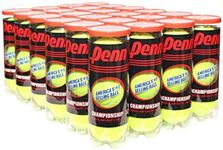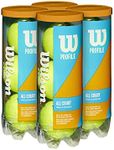Buying Guide for the Best Tennis Balls
Choosing the right tennis balls can significantly impact your game, whether you're a beginner or an advanced player. Tennis balls come in various types and specifications, each designed to cater to different playing styles, court surfaces, and levels of play. Understanding these specifications will help you select the best tennis balls for your needs, ensuring optimal performance and enjoyment on the court.TypeTennis balls come in different types, such as regular duty, extra duty, and high altitude. Regular duty balls are designed for clay or indoor courts, while extra duty balls are meant for hard courts. High altitude balls are used in locations above 4,000 feet. Choosing the right type depends on the court surface you play on most frequently. If you play on hard courts, go for extra duty balls; for clay or indoor courts, regular duty balls are ideal.
PressureTennis balls can be pressurized or pressureless. Pressurized balls offer more bounce and are commonly used in professional matches, but they lose their bounce over time. Pressureless balls maintain their bounce longer and are ideal for practice sessions. If you're looking for balls that last longer for training, pressureless balls are a good choice. For competitive play, pressurized balls are preferred.
DurabilityDurability refers to how long the tennis balls maintain their performance characteristics, such as bounce and felt quality. Extra duty balls tend to be more durable on hard courts, while regular duty balls are better suited for softer surfaces. If you play frequently, consider balls known for their durability to avoid frequent replacements.
BounceBounce is crucial for the consistency of play. Tennis balls are designed to have a specific bounce height when dropped from a certain height. Pressurized balls generally have a higher bounce initially but lose it over time, while pressureless balls maintain a consistent bounce. Choose pressurized balls for competitive play where bounce consistency is critical, and pressureless balls for extended practice sessions.
Felt QualityThe felt covering on tennis balls affects their flight and durability. High-quality felt provides better control and lasts longer, while lower-quality felt may wear out quickly. If you prioritize control and longevity, opt for balls with high-quality felt. For casual play, felt quality may be less critical.
ColorMost tennis balls are yellow for visibility, but they can come in other colors for specific purposes, such as training or playing on different surfaces. Yellow balls are standard for most play, but if you have specific needs, such as playing on a surface where yellow is hard to see, consider alternative colors.















